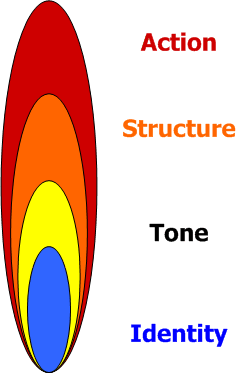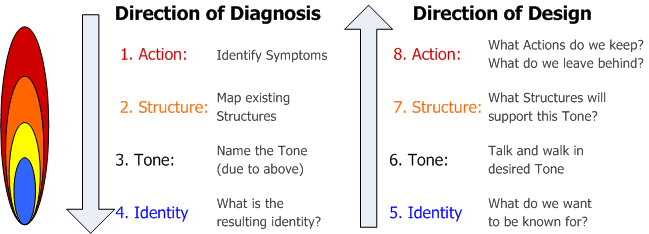 This model can lead to some great conversations by shifting leader’s attention from actions and structure to identity and tone, the inner two aspects of the flame model.
This model can lead to some great conversations by shifting leader’s attention from actions and structure to identity and tone, the inner two aspects of the flame model.
Several companies have spent large sums of money bringing in consulting companies to address process improvements, only to discover after years have past and millions of dollars spent, the same problems exist. An explanation for this is provided by considering the flame model. This model is used in Dialogos’Leadership for Collective Intelligence program and is a varient of their Dynamics For System Intervention model.
ACTIONS: The top level of the flame is the most visible, what are people doing and clearly an essential focus in leading a successful organization. Easy to measure, easy to identify problems, easy to add a Next Actions agenda item at the end of meetings.
STRUCTRE: For sustainable change, the typical next place to focus is to improve the structure, the procedures, and the process. Working in IT, I have seen many process changes and am currently proposing we change to an agile process. I know that without changing the tone and identity of the IT department we will not succeed in bringing about sustainable change.
TONE: This is quality of the energy in an organization, the atmosphere, the mood. One way I feel it today is in the reactive fire fighting modes IT operates in – this actually fuels action but not in a sustainable way as it is often followed by burn out. Cars.com introduced a new branding message for our super bowl commercial “Confidence Comes Standard” – this is a tonal message. I would love to change the tone of IT to one of relaxed confidence.
IDENTITY: This is the core of the flame. When leaders of organizations focus on the core vision, mission and how they identify themselves, they can then set the desired tone, through authentic communications and actions. From this place creating structures and associated actions flow easily. All the successful entrepreneurial companies I meet in Chicago have a very well defined identity; examples that spring to mind are Threadless and Feedburner.
For leaders to use this model in introducing change, it is helpful to go down the flame in diagnosing the current problems, then up the flame to introduce the desired furture state.

